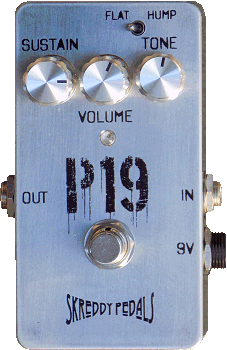Official Skreddy P19 Page HERE
P19 (released 1-25-12)(How many made?)(Highest known number -)(RETIRED – 9-10-19, replaced by General Pig)


Marc Says (via TGP):?
“The P19 is smooth, refined, fairly compressed, and has the highs and lows really dialed–velvety but still a nice amount of aggression…I’ve been trying to tell people for a long time that the P19 does “The Wall” tones much better than the old Pink Flesh, but it’s hard to break a myth.”
“it’s definitely just a “Big Muff” style fuzz, same idea as the Pig Mine (which it is replacing). But it has a clearer voice, better balance on the eq, and lower noise. I just quietly made the switch yesterday evening. I had been working on the P19 for months and finally decided I was done yesterday after revisiting it to confirm that it does indeed sound good with fresh ears and does not need any improvement. It has the ability to get lower gain sounds than the Pig Mine, which was always high gain even with the sustain knob set way low.”
“Get to know it: start with all knobs at noon. Play; should be fairly clear and balanced. Then turn all knobs to 1:00 o’clock. Play; should be a touch more aggressive and cutting. Now you have an idea, quickly, of what works better for your amp. Fairly good to go with knobs close to noon and adjusting in small increments. Some real fun with sustain cranked too of course (but then only useful for leads and not so much rhythm of course). If you have a scooped amp (e.g., Fender), the mids switch to “Hump” will definitely help.”
“Yep. But play the opening note of “In the Flesh” with a P19. It gets that fuzzy attack but without any boominess, just like it should. I don’t make the Mayo anymore, but it was great at that full, heavy wall-of fuzz with the big bottom.”
The functional range on the sustain control does go a lot lower; and the tone has a subtly but noticeably clearer nature. The transistors do less of the distorting in this one and let the diodes do their clipping in a more precise way. I still use my secret sauce diode combination for ever-so-slightly asymmetrical clipping, just to keep it interesting.
I don’t know how much you’ll appreciate the effect of the flat/hump switch; it’s roughly the same difference (though this tone stack does have a different basic formulation). I only put as much boost into that switch as I think will be needful while keeping its essential nature intact. It’s there to pop up the mids, just enough, to keep from getting swamped in a live mix, but not to give you two different sounds.
I actually experimented with a more powerful form of the switch a few years back, a double-pole, double-throw switch, just to be able to have total control. But I didn’t think it needed be so dramatic after playing with it for a few minutes.
